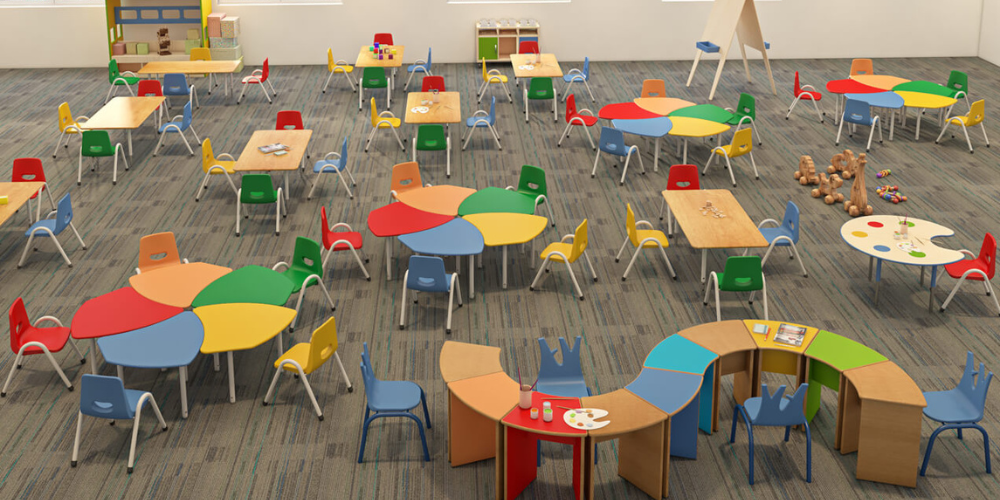Do you want to have a learning space with the specs of flexibility and adaptability as the key ingredient?
Let’s learn it here to know how traditional classrooms no longer meet the needs of today’s learners. Modular furniture comes into place when we want a dynamic and versatile learning space for children to thrive.
Now designing classrooms is more than an art where we support different teaching styles that reflect students' and teachers' needs and preferences.
Some of the innovative ways in which modular furniture can transform a traditional, boring classroom into a dynamic and engaging space are given below.
Modular Desks and Tables
Think of creativity, and plan on getting modular desks and tables. Long gone are the days when the same-length and same-height desks and tables were needed in the classroom. Now with modular desks and tables, you can create a wide range of seating designs and ideas that can fit particularly to some group or individual work.
This independence in creating versatile seating arrangements leads to better building a teamwork and collaborative space that can improve interaction and student engagement.
You can make a circular or a semi-circular or U-shaped seating arrangement by using modular furniture, giving you the liberty to create your own sitting collections that enhance social interaction among children. You can get modular preschool furniture for sale to get the best customized items of furniture for your classroom.
Flexible Seating
Now, the children have the flexibility to choose their seating options. It is quite a popular trend that makes bean bags, wobble stools, standing desks, or floor cushions a choice for children to select whatever they feel comfortable working on.
The independence to select where the children can sit will make them reduce stress and fatigue and also make them feel confident that they can choose what they wish.
Flexible seating options allow studentsdent to perform well and have a more personalized learning experience.
Mobile Storage
With the advancement in structural and interior design of learning spaces,, we need to consider frequent reconfiguration. Modular furniture makes it a viable option to get the free movement of furniture in the classroom to make it possible for students to quickly access their learning materials.
Mobile storage units can help to divide classrooms into smaller learning zones like reading corners or project areas. These portable storages provide easy access to related materials in whatever place a child needs.
This increases the customized spaces that works by increasing children's engagement in the classroom.
Collaborative Workspaces
The most crucial aspect of modern-day classroom interior design is to create collaborative workspaces that increase children's ability to talk with other fellows and improve their communication.
Modular furniture can be used to create a workspace that may include individual pods for increasing a child’s performance. We can also take the help of booths or tables to complete group projects or discussions.
Modular furniture also can help create a break-out area that allows children to get a necessary break or change of scenery to refresh minds.
The design spaces can also arrange different group sizes ranging from working in pairs to larger teams.
Multi-Functional Furniture
Unique storage and seating solutions are the new trend in modular furniture. It provides the built-in storage options for seating and storage simultaneously.
Modular furniture with multi-function furniture helps to optimize space utilization. It also reduces the visible clutter and creates an organized and streamlined learning environment.
Technology Integration
Modern-day classroom needs are immensely power-packed by intelligent technology integration. To provide digital resources to children modular furniture design integrates with technology seamlessly. Power outlets, charging stations,built-in screens help a child use the technology with peace of mind promoting digital literacy and imparting creativity in young minds.
Acoustic Solutshanging technological needs one may need to design learning spaces that have less noise improving the concentration and enhancing focus.students' and educators' needs and preferences
Modular furniture creates different acoustic zones including quiet reading corners or soundproof individual pods. Such acoustic solutions promote privacy, it also helps autistic children who may feel the urge to cut noise to concentrate on learning. Acoustic solutions are particularly helpful in open-plan learning spaces where there are multiple sects of children implementing various modes of learning.
Conclusion
Acoustic furniture has the capacity to change a class to a dynamic functioning learning environment which multiples student engagement and enhances the concentration.to


